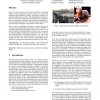Free Online Productivity Tools
i2Speak
i2Symbol
i2OCR
iTex2Img
iWeb2Print
iWeb2Shot
i2Type
iPdf2Split
iPdf2Merge
i2Bopomofo
i2Arabic
i2Style
i2Image
i2PDF
iLatex2Rtf
Sci2ools
APGV
2006
ACM
2006
ACM
Verification of rendering quality from measured BTFs
One of the most important, still unsolved problems in computer graphics is the generation of predictive imagery, i.e., images that represent perfect renditions of reality. Such perfect images are required in application areas like Virtual Prototyping for making reliable decisions in the costly design development of novel products like cars and airplanes. Recently, measured material properties received significant attention since they enable generation of highly accurate images that appear to be predictive at a first glance. In this work we investigate the degree of realism that can be achieved using measured bidirectional texture functions (BTFs) by comparing photographs and rendered images at two scales. To analyze the realism of rendered images at a coarse scale, we compare the light distribution resulting from standard materials to the one from measured BTFs by automatic procedures. At a fine scale, accurate reproduction of material structures is checked by a psychophysical study. ...
| Added | 13 Oct 2010 |
| Updated | 13 Oct 2010 |
| Type | Conference |
| Year | 2006 |
| Where | APGV |
| Authors | Jan Meseth, Gero Müller, Reinhard Klein, Florian Röder, Michael Arnold |
Comments (0)

